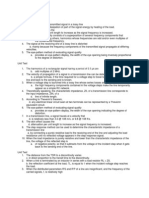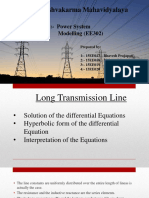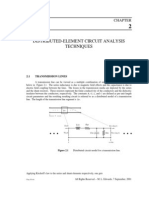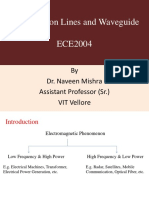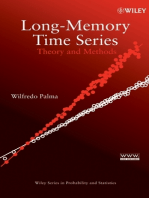Lecture 10a - Notes - Single-Phase Distributed Parameter Line Modeling
Uploaded by
malcovichjohn23Lecture 10a - Notes - Single-Phase Distributed Parameter Line Modeling
Uploaded by
malcovichjohn23Distributed Parameter Line Modeling
Distributed Parameter Line Modeling – Single Phase
Transmission Line Equations
The lumped-parameter representation of a transmission line is sufficient for low frequency
calculations. However for higher frequency events, such as those associated with lightning strikes
or switching, we will not obtain the proper results. In these situations we will have to model how
the inductance and capacitance is actually distributed along the line. For this reason, this next type
of model will be referred to as a “distributed-parameter model” as opposed to a lumped-line model.
In order to come up with a model, we will assume that a line is composed of small differential
segments of the type shown below in Fig. 6, where ∆x is the length of the segment. We are
neglecting the resistance, which will give us a lossless line model. The inductance L and
capacitance C are given in terms of Henries/meter and Farads/meter. The voltage drop across this
element is given by
∂i
−∆v= L∆x (1)
∂t
In the limit as ∆x approaches zero, we can rewrite this equation as
∂v ∂i
= −L (2)
∂x ∂t
where we are using partial derivatives in this formulation since voltage and current are functions
of both position along the line segment and time.
I L∆x I+∆I
+ +
∆I
V C∆x V+∆V
- -
∆x
Fig. 6 Line Segment Model
The relationship between the capacitor charging can be approximated by
∂v
−∆i= C ∆x (3)
∂t
Again in the limit as ∆x approaches zero, we get
∂i ∂v
= −C (4)
∂x ∂t
We can now eliminate the current as a variable by taking the partial of equation (2) and equation
(4) with respect to x and t respectively and substituting one into the other as follows:
ECE 587 Power System Transients Analysis 1
Distributed Parameter Line Modeling
∂ 2v ∂i 2
From (2) = − L (5)
∂x 2 ∂x∂t
∂ 2i ∂ 2v
From (4) = −C 2 (6)
∂x∂t ∂t
And finally
∂ 2v ∂ 2v
= LC (7)
∂x 2 ∂t 2
Similarly for the current, starting with (4) and (2):
∂ 2i ∂ 2v
= −C (8)
∂x 2 ∂x∂t
2
∂v ∂ 2i
= −L 2 (9)
∂x∂t ∂t
which leads to
∂ 2i ∂ 2i
= LC 2 (10)
∂x 2 ∂t
Equations (7) and (10) are the two relationships which define voltage and current on a lossless
transmission line as a function of distance and time. The solution for current will have the form
i ( x, t ) = f1 ( x − υ t ) + f 2 ( x + υ t ) (11)
where
1
υ= (12)
LC
We can verify this by substituting (11) into (10) and show that the equality holds. If the solution
for current has this particular form then if the voltage and current are related by (2) then
∂v ∂i ∂f ( x − υ t ) ∂f 2 ( x + υ t )
= −L = −L 1 +
∂x ∂t ∂t ∂t (13)
= Lυ f1' ( x − υ t ) − f 2 ' ( x + υ t )
and integrating both side with respect to x
= v Lυ f1 ( x − υ t ) − f 2 ( x + υ t )
(14)
= Z o f1 ( x − υ t ) − Z o f 2 ( x + υ t )
Note that the voltage is related to the current by an impedance where
L L
Z=
o υ
L= = (15)
LC C
ECE 587 Power System Transients Analysis 2
Distributed Parameter Line Modeling
Next we need to discuss what f1 and f2 represent. If we were to plot f1 ( x − υ t ) at times
corresponding to t=0 and t= τ , then we would have the two waveforms f1 ( x ) and f1 ( x − υτ ) as
shown in Fig. 7, assuming that the waveform had a triangular shape. It appears from this diagram
1
b g
that f1 x − υt represents a waveform traveling to the right at a velocity of υ =
LC
, in the
b g
direction of increasing x. Similarly it can be shown that f 2 x + υτ represents a traveling wave
b
moving to the left in the direction of decreasing x. We would say in this case that f1 x − υτ g
b g
represents a forward traveling wave and f 2 x + υτ represents a backward traveling wave. It is
also interesting to compare equation (11) to (14) which shows that the forward traveling wave
components of the voltage and current differ by a positive impedance while the backward traveling
wave components of the voltage and current differ by a negative impedance. The solution also
suggests that on a loss-free line, that the corresponding voltage and current have the same
waveshape.
t=0 t=τ
f
x=0 x=υτ x-position
Fig. 7 Traveling Waveform
ECE 587 Power System Transients Analysis 3
Distributed Parameter Line Modeling
Reflection and Refraction Coefficients
When a traveling wave on a transmission line hits a discontinuity, due to a connection to a line
with a different impedance, then the energy will be divided into a reflected wave and a refracted
wave. Superimposing the forward and reflected waveform gives the total line voltage and current.
We can compute reflection and refraction coefficients based on the scenario shown in Fig. 8, where
cables A and B have different surge impedances. For the forward traveling wave (to the right),
the relationship between voltage and current magnitude will be given by:
V1
I1 = (16)
ZA
At the discontinuity between the two cables we will get a reflected wave with magnitude V2 and a
refracted wave with magnitude V3, where
V V3
I2 =
− 2 ; I3 = (17)
ZA ZB
The subscript 1 will refer to the forward traveling incident waveform, while subscripts 2 and 3 will
refer to the reflected and refracted waveforms.
V1
ZA ZB
Fig. 8 Discontinuity Caused by Cable Connection
In order for voltage and current to be continuous at the intersections between the two cables
we have the following two boundary conditions
V1 + V2 =V3 (18)
I1 + I 2 =
I3 (19)
If we substitute (16) and (17) into (19) we get
V1 V2 V3
− = (20)
Z A Z A ZB
Substituting (18) into (20)
V1 V2 V1 + V2 V1 V2
− = = + (21)
ZA ZA ZB ZB ZB
Equating the coefficients for the voltage terms
ECE 587 Power System Transients Analysis 4
Distributed Parameter Line Modeling
1 1 Z A − ZB 1 1 Z A + ZB
− V1 = V1 = + V2 = V2 (22)
Z A ZB Z AZB Z A ZB Z AZB
where the ratio between the reflected and incident voltage is called the reflection coefficient and
is defined by
V Z − ZA
Γa = 2 = B (23)
V1 Z B + Z A
For various values of cable impedances this reflection coefficient can vary between –1 and 1.
To obtain the relationship between the magnitude of the refracted and the incident wave we
again substitute (18) into (20), but this time looking at the relationship between V3 and V1.
V1 V3 − V1 V3
− = (24)
ZA ZA ZB
Equating the coefficients for the voltage terms again
2 1 1 Z A + ZB
V1 = + V3 = V3 (25)
ZA ZB Z A Z AZB
If we take the ratio of the refracted to the incident voltage we get a refraction coefficient defined
by
V 2Z B
Γb = 3 = (26)
V1 Z B + Z A
For various values of impedance this refraction coefficient can vary between 0 and 2.
Suppose that we have a step function voltage applied to a line. A voltage waveform will
propagate down the line as shown in Fig. 9. When this step function hits the discontinuity a
reflection will be generated with an amplitude of V2 = Γ aV1 . This reflection will be a backward
traveling wave which when superimposed with the forward traveling wave will give us the total
voltage as a function of time and position on the first transmission line. A refracted wave will be
injected into the second transmission line with an amplitude given by V3 = ΓbV1 . When this
refracted wave traveling in the forward direction hits a new discontinuity, then this will produce
another reflected waveform.
ECE 587 Power System Transients Analysis 5
Distributed Parameter Line Modeling
Before Hitting After Hitting
Discontinuity Discontinuity
V1
V3
V1
V2
Discontinuity Discontinuity
Fig. 9 Voltage Waveforms at Discontinuity
As a quick example of how these coefficients can be applied to a power system, consider the
case of an overhead line connected to an underground cable. The overhead cable has an impedance
of ZA= 400 Ohms and the underground cable has an impedance of ZB= 50 Ohms. Suppose that a
surge with an amplitude of 300 kV is traveling down the overhead line, then how much of this
voltage will get into the underground cable? This can be determined by looking at the refraction
coefficent:
2Z B 2 × 50
= Γb = = 0.22 (27)
Z B + Z A 50 + 400
Multiplying the magnitude of the incident waveform times this refraction coefficient gives us
0.22x300kV=66kV. An overvoltage on an overhead circuit might result in a flashover, which
would not necessarily result in permanent damage. However, an overvoltage on an underground
cable would likely damage the insulation and possibly destroy the cable.
It is also possible that instead of having a second transmission line, we have an open circuit
instead. In this case the impedance Z B = ∞ which will give us a reflection coefficient of Γ A = 1
and a refraction coefficient of Γ B = 2 . This means that an incident wave traveling down the line
will have a reflected wave of the same magnitude, which basically gives us a voltage doubling
effect. This is the reason why underground cables normally need surge arrestors at the ends of the
circuit.
Lattice Diagrams
A methodology referred to as lattice (or pulse-bounce) diagrams has been developed to track
the forward and backward traveling waveforms on a transmission system. A lattice diagram,
shown in Fig. 10, has a vertical time scale which is usually set up in units corresponding to the
time it takes a waveform to travel from one end of the line to the next. This time factor is defined
by
line length l
= τ = = l LC (28)
velocity 1/ LC
The horizontal axis of the lattice diagram corresponds to position. Using this tool, one can
determine the voltage (or current) as a function of time and position. At a given time and position
the voltage (current) is found by summing up all the waves that have passed in both directions up
ECE 587 Power System Transients Analysis 6
Distributed Parameter Line Modeling
to that particular time. If this line had losses, then the waveshapes would be both attenuated and
distorted. However for this lossless case the waveshapes maintain their integrity.
z=0 Position z=length
0
V1 Reflection
Time
τ Coefficient
Γa1V1 Γa1
Reflection
Coefficient 2τ Γa2Γa1V1
Γa2
3τ Γa2(Γa1)2V1
4τ
5τ
6τ
Fig. 10 Lattice Diagram
Sources that inject a waveform into a cable typically have an output impedance. If the voltage
is represented by Vs and the source impedance is given by Rs, then for a cable of surge impedance
Zo, the incident waveform magnitude is
Zo
V1 = Vs (29)
Rs + Z o
The source impedance also factors into the computation of the reflection coefficient at the source
end of the circuit, where
R − Zo
Γ a = s (30)
Z o + Rs
Sometime resistance is purposefully inserted at the source end of the circuit. This is done to reduce
the initial amount of voltage which is injected into the transmission line when it is energized. This
element inserted to accomplish this is called a closing resistor and it would have the effect of
minimizing transient overvoltages.
ECE 587 Power System Transients Analysis 7
Distributed Parameter Line Modeling
EMTP Models
From the solution to the partial differential equations that describe how voltage and current
vary on a lossless transmission line, we saw that:
i ( x, t ) = f1 ( x − υ t ) + f 2 ( x + υ t ) (31)
v ( x,=
t ) Z o f1 ( x − υ t ) − Z o f 2 ( x + υ t ) (32)
where
1
υ= (33)
LC
L
Zo = (34)
C
If we multiply (31) by Zo and then add the result to (32) we get
v( x, t ) + Z oi ( x, t ) = 2 Z o f1 ( x − υ t ) (35)
This equation tells us that the sum of the voltage plus impedance times the current is constant with
respect to an observer traveling down the transmission line in the direction of increasing x at a
velocity υ . Suppose that we are now trying to model the transmission line shown in Fig. 11. The
time it takes for a waveform to propagate down the line is given by τ . The term v + Zoi as seen
by an observer at node k at t=0 must be the same as seen by the observer at node m at t= τ .
ik,m(t) im,k(t)
k m
+ +
vk(t) vm(t)
- -
Fig. 11 Transmission Line
We can take this relationship and use it to build an ATP line model, where
) vk ( t ) + Z o ( −ik ,m ( t ) )
vm ( t − τ ) + Z oim ,k ( t − τ = (36)
Solving for the current at node k, we could also state
ECE 587 Power System Transients Analysis 8
Distributed Parameter Line Modeling
1 1 1
m (t )
ik ,= vk ( t ) − vm ( t − τ ) − im,k ( t=
−τ ) vk ( t ) + I k ( t − τ ) (37)
Zo Zo Zo
1
Ik (t −τ ) = − vm ( t − τ ) − im,k ( t − τ ) (38)
Zo
Alternately for waveforms traveling in the opposite direction
) vm ( t ) + Z o ( −im,k ( t ) )
vk ( t − τ ) + Z oik ,m ( t − τ= (39)
1 1 1
,k ( t )
im= vm ( t ) − vk ( t − τ ) − ik ,m ( t=
−τ ) vm ( t ) + I m ( t − τ ) (40)
Zo Zo Zo
1
Im (t −τ ) = − vk ( t − τ ) − ik ,m ( t − τ ) (41)
Zo
Equations (37), (38), (40) and (41) are formulated in the same format we used for the network
modeling described earlier in the semester. The relationship between voltage and current is given
in terms of an impedance and a parallel current source. These equations can also be illustrated in
the equivalent model shown in Fig. 12.
ik,m(t) im,k(t)
+ +
Ik(t-τ)
vk(t) Zo Zo vm(t)
Im(t-τ)
- -
Fig. 12 EMTP Line Model
ECE 587 Power System Transients Analysis 9
You might also like
- Canon EF 100-400 4.5-5.6L Is USM Repair ManualNo ratings yetCanon EF 100-400 4.5-5.6L Is USM Repair Manual9 pages
- CB Defense User Guide: CB Predictive Security CloudNo ratings yetCB Defense User Guide: CB Predictive Security Cloud178 pages
- Transmission Lines: 1 A Lossless Transmission LineNo ratings yetTransmission Lines: 1 A Lossless Transmission Line20 pages
- Characteristic Impedance Contnd.: - Air Dielectric Parallel LineNo ratings yetCharacteristic Impedance Contnd.: - Air Dielectric Parallel Line23 pages
- FDTD Method For Lightning Surge Propagation of Power Transmission LinesNo ratings yetFDTD Method For Lightning Surge Propagation of Power Transmission Lines5 pages
- Fault Location On A Transmission Line Using High Frequency TraveNo ratings yetFault Location On A Transmission Line Using High Frequency Trave6 pages
- Relaying Applications of Traveling Waves: Dr.M.Manjula ProfessorNo ratings yetRelaying Applications of Traveling Waves: Dr.M.Manjula Professor61 pages
- Impedance Matching 1 Lecture For July 2, 2013100% (1)Impedance Matching 1 Lecture For July 2, 201391 pages
- PST UnitIV TravellingWaveinTransmissionLine SilasStephenNo ratings yetPST UnitIV TravellingWaveinTransmissionLine SilasStephen23 pages
- Time Domain Reflectometry Theory: Application NoteNo ratings yetTime Domain Reflectometry Theory: Application Note16 pages
- 2.3 - The Terminated Lossless Line - Engineering LibreTextsNo ratings yet2.3 - The Terminated Lossless Line - Engineering LibreTexts11 pages
- ) : ∂ ∂z µE (2.29) γ µ, which, for lossless β = ω µ = ω, (2.30)No ratings yet) : ∂ ∂z µE (2.29) γ µ, which, for lossless β = ω µ = ω, (2.30)8 pages
- Lecture Notes in Transmission Media and Antenna Systems: Mapua Institute of Technology School of EeceNo ratings yetLecture Notes in Transmission Media and Antenna Systems: Mapua Institute of Technology School of Eece115 pages
- Annex 3 - Delivery Format - Task 3 Miguel PamplonaNo ratings yetAnnex 3 - Delivery Format - Task 3 Miguel Pamplona17 pages
- Comparison of HVDC Line Models in PSB Simulink BasedNo ratings yetComparison of HVDC Line Models in PSB Simulink Based6 pages
- Feynman Lectures Simplified 2C: Electromagnetism: in Relativity & in Dense MatterFrom EverandFeynman Lectures Simplified 2C: Electromagnetism: in Relativity & in Dense MatterNo ratings yet
- Student Solutions Manual to Accompany Economic Dynamics in Discrete Time, secondeditionFrom EverandStudent Solutions Manual to Accompany Economic Dynamics in Discrete Time, secondedition4.5/5 (2)
- ADVANCED FOOTSTEP POWER GENERATION SYSTEM - 4 Steps - InstructablesNo ratings yetADVANCED FOOTSTEP POWER GENERATION SYSTEM - 4 Steps - Instructables26 pages
- ASB 412-00-103 - Cargo Hook, Onboard Systems P - N 528-002-00 Rev. A - 09-Sep-2002No ratings yetASB 412-00-103 - Cargo Hook, Onboard Systems P - N 528-002-00 Rev. A - 09-Sep-20027 pages
- A Novel Healthy and Time Aware Food Recommender Syst - 2023 - Expert Systems Wit PDFNo ratings yetA Novel Healthy and Time Aware Food Recommender Syst - 2023 - Expert Systems Wit PDF22 pages
- Symantec DLP 15.5 System Requirements GuideNo ratings yetSymantec DLP 15.5 System Requirements Guide75 pages
- Instrument Cluster: Ymms: Mar 9, 2020 Engine: 1.6L Eng License: Vin: Odometer: 2018 Hyundai Kona LimitedNo ratings yetInstrument Cluster: Ymms: Mar 9, 2020 Engine: 1.6L Eng License: Vin: Odometer: 2018 Hyundai Kona Limited6 pages
- 4th Sem Detailed Syllabus (B. Sc. in Data Science)No ratings yet4th Sem Detailed Syllabus (B. Sc. in Data Science)5 pages
- Elementary Matrices and RREF: N N I Ij IjNo ratings yetElementary Matrices and RREF: N N I Ij Ij3 pages
- Release Notes For Cisco Catalyst 9800 Series Wireless Controller, Cisco IOS XE Bengaluru 17.6.xNo ratings yetRelease Notes For Cisco Catalyst 9800 Series Wireless Controller, Cisco IOS XE Bengaluru 17.6.x57 pages
- CATALOG CODE: QJ50QT-2 2009 Version F01 Control Assy. NO. Code Description QTY Notes Season Old CodeNo ratings yetCATALOG CODE: QJ50QT-2 2009 Version F01 Control Assy. NO. Code Description QTY Notes Season Old Code25 pages
- Applied Tele Audiology Research in Clinical Practice During The Past Decade A Scoping ReviewNo ratings yetApplied Tele Audiology Research in Clinical Practice During The Past Decade A Scoping Review10 pages
- BSBPMG610 Enable Program Execution: Task 1-Knowledge QuestionsNo ratings yetBSBPMG610 Enable Program Execution: Task 1-Knowledge Questions7 pages
- DTI Directory of Key Officials As of 24 June 2024No ratings yetDTI Directory of Key Officials As of 24 June 202433 pages
- Detection of Cyber Attack in Network using Machine Learning Techniques (1)No ratings yetDetection of Cyber Attack in Network using Machine Learning Techniques (1)68 pages
- English Sample Unit: Pictures Tell The Story! Stage 2No ratings yetEnglish Sample Unit: Pictures Tell The Story! Stage 218 pages
- SYNC IEC60870-5 104 Slave Interface Usermanual Rev1.0.9No ratings yetSYNC IEC60870-5 104 Slave Interface Usermanual Rev1.0.924 pages
- Syllabus Database Management For Business Fall 2024-2025-1No ratings yetSyllabus Database Management For Business Fall 2024-2025-19 pages
- CB Defense User Guide: CB Predictive Security CloudCB Defense User Guide: CB Predictive Security Cloud
- Transmission Lines: 1 A Lossless Transmission LineTransmission Lines: 1 A Lossless Transmission Line
- Characteristic Impedance Contnd.: - Air Dielectric Parallel LineCharacteristic Impedance Contnd.: - Air Dielectric Parallel Line
- FDTD Method For Lightning Surge Propagation of Power Transmission LinesFDTD Method For Lightning Surge Propagation of Power Transmission Lines
- Fault Location On A Transmission Line Using High Frequency TraveFault Location On A Transmission Line Using High Frequency Trave
- Relaying Applications of Traveling Waves: Dr.M.Manjula ProfessorRelaying Applications of Traveling Waves: Dr.M.Manjula Professor
- PST UnitIV TravellingWaveinTransmissionLine SilasStephenPST UnitIV TravellingWaveinTransmissionLine SilasStephen
- Time Domain Reflectometry Theory: Application NoteTime Domain Reflectometry Theory: Application Note
- 2.3 - The Terminated Lossless Line - Engineering LibreTexts2.3 - The Terminated Lossless Line - Engineering LibreTexts
- ) : ∂ ∂z µE (2.29) γ µ, which, for lossless β = ω µ = ω, (2.30)) : ∂ ∂z µE (2.29) γ µ, which, for lossless β = ω µ = ω, (2.30)
- Lecture Notes in Transmission Media and Antenna Systems: Mapua Institute of Technology School of EeceLecture Notes in Transmission Media and Antenna Systems: Mapua Institute of Technology School of Eece
- Annex 3 - Delivery Format - Task 3 Miguel PamplonaAnnex 3 - Delivery Format - Task 3 Miguel Pamplona
- Comparison of HVDC Line Models in PSB Simulink BasedComparison of HVDC Line Models in PSB Simulink Based
- Feynman Lectures Simplified 2C: Electromagnetism: in Relativity & in Dense MatterFrom EverandFeynman Lectures Simplified 2C: Electromagnetism: in Relativity & in Dense Matter
- Student Solutions Manual to Accompany Economic Dynamics in Discrete Time, secondeditionFrom EverandStudent Solutions Manual to Accompany Economic Dynamics in Discrete Time, secondedition
- ADVANCED FOOTSTEP POWER GENERATION SYSTEM - 4 Steps - InstructablesADVANCED FOOTSTEP POWER GENERATION SYSTEM - 4 Steps - Instructables
- ASB 412-00-103 - Cargo Hook, Onboard Systems P - N 528-002-00 Rev. A - 09-Sep-2002ASB 412-00-103 - Cargo Hook, Onboard Systems P - N 528-002-00 Rev. A - 09-Sep-2002
- A Novel Healthy and Time Aware Food Recommender Syst - 2023 - Expert Systems Wit PDFA Novel Healthy and Time Aware Food Recommender Syst - 2023 - Expert Systems Wit PDF
- Instrument Cluster: Ymms: Mar 9, 2020 Engine: 1.6L Eng License: Vin: Odometer: 2018 Hyundai Kona LimitedInstrument Cluster: Ymms: Mar 9, 2020 Engine: 1.6L Eng License: Vin: Odometer: 2018 Hyundai Kona Limited
- 4th Sem Detailed Syllabus (B. Sc. in Data Science)4th Sem Detailed Syllabus (B. Sc. in Data Science)
- Release Notes For Cisco Catalyst 9800 Series Wireless Controller, Cisco IOS XE Bengaluru 17.6.xRelease Notes For Cisco Catalyst 9800 Series Wireless Controller, Cisco IOS XE Bengaluru 17.6.x
- CATALOG CODE: QJ50QT-2 2009 Version F01 Control Assy. NO. Code Description QTY Notes Season Old CodeCATALOG CODE: QJ50QT-2 2009 Version F01 Control Assy. NO. Code Description QTY Notes Season Old Code
- Applied Tele Audiology Research in Clinical Practice During The Past Decade A Scoping ReviewApplied Tele Audiology Research in Clinical Practice During The Past Decade A Scoping Review
- BSBPMG610 Enable Program Execution: Task 1-Knowledge QuestionsBSBPMG610 Enable Program Execution: Task 1-Knowledge Questions
- Detection of Cyber Attack in Network using Machine Learning Techniques (1)Detection of Cyber Attack in Network using Machine Learning Techniques (1)
- English Sample Unit: Pictures Tell The Story! Stage 2English Sample Unit: Pictures Tell The Story! Stage 2
- SYNC IEC60870-5 104 Slave Interface Usermanual Rev1.0.9SYNC IEC60870-5 104 Slave Interface Usermanual Rev1.0.9
- Syllabus Database Management For Business Fall 2024-2025-1Syllabus Database Management For Business Fall 2024-2025-1


